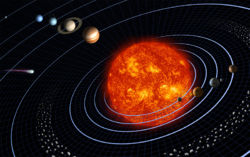Planet
 From Conservapedia
From Conservapedia A planet is an astronomical body that is in orbit around a star, that has sufficient mass for its own gravity to overcome rigid body forces, assumes an approximately spherical shape, and has cleared the neighborhood around its orbit,[1] i.e. has "swept out" the area around its orbit during its formation, accreting into its mass all other smaller bodies within its orbit. Consequently, a planet does not share its orbital region with any other bodies of significant size, except for its satellites or those collected later by virtue of its gravitational field.
The order of the planets, from the Sun outward, is:
Pluto is no longer considered a regular planet; it was reclassified to a Dwarf Planet by the IAU, along with Ceres, Haumea, Makemake and Eris.
An easy way to remember this order is, "Mary's violet eyes make Johnny stay up nights." [1] (The first letter of each word reminds you of the planet's name.)
Young Earth Creationism View[edit]
Young earth creationists assert that materialistic explanations of the planet formation are inadequate and contra-evidential.[2][3] In addition, creationists often cite the secular scientific literature in order to make the case that materialist explanations of planet formation are inadequate:
“... most every prediction by theorists about planetary formation has been wrong.” Scott Tremaine, as quoted by Richard A. Kerr who was proposing a new planetary formation model, “Jupiters Like Our Own Await Planet Hunters,” [4]
"No one knows quite how planetesimals ever attain protoplanet status." [5]
“It turns out to be surprisingly difficult for planetesimals to accrete mass during even the most gentle collisions.” Erik Asphaug, “The Small Planets,” [6]
References[edit]
- ↑ http://www.iau.org/iau0603.414.0.html
- ↑ http://www.creationscience.com/onlinebook/AstroPhysicalSciences3.html
- ↑ http://www.answersingenesis.org/home/area/faq/astronomy.asp
- ↑ Science, Vol. 295, 25 January 2002, p. 605 cited at: http://www.creationscience.com/onlinebook/ReferencesandNotes43.html
- ↑ D. Kaisler, The puzzles of planethood, Sky & Telescope 104(2):32-38, 2002.
- ↑ Scientific American, Vol. 282, May 2000, p. 54. cited at: http://www.creationscience.com/onlinebook/ReferencesandNotes46.html
| |||||||||||||||||||||||||||||
Categories: [Astronomy]
↧ Download as ZWI file | Last modified: 03/10/2023 16:43:35 | 56 views
☰ Source: https://www.conservapedia.com/Planet | License: CC BY-SA 3.0
 ZWI signed:
ZWI signed:

 KSF
KSF